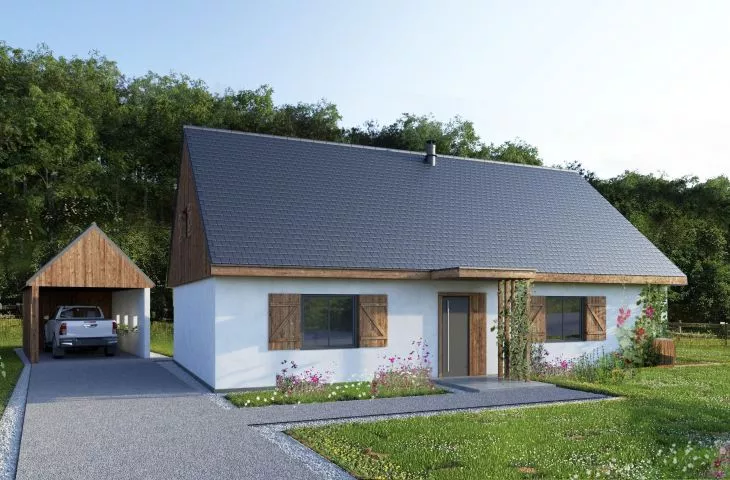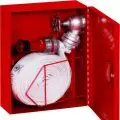Architects from {tag:pracownie} designed a single-family house in Marczow near the Bóbr Valley Landscape Park. The building is being constructed in the surroundings of rural half-timbered buildings, which influenced its simple body and form. Material solutions and contemporary treatment of traditional details, corresponds to the old architecture of the region.
The designed single-family house is on a rectangular plan with an area of 91 square meters with a symmetrical gable roof, and has been positioned similarly to the neighboring houses - parallel to the road, fitting in with the village layout. The building on the street side has a more traditional character - we can see references to an old country cottage, while on the south side of the garden the windows are larger, making the building more modern.
The house was supplemented with a shed, thus creating a semi-enclosed courtyard
© Tecla
The functional layout of the house corresponds with the simple body of the building and relates to the terrain context of the plot. When arranging the plot, the architects took inspiration from rural homestead buildings and supplemented it with a shed set perpendicular to the building. This created a semi-enclosed courtyard with a backyard terrace.
tradition and modernity
The architects assumed that the living area would be on the first floor, leaving a partially separated attic as additional space, intended for flexible arrangement in the future with the inclusion, for example, of a sauna with a bathroom. The living room with kitchenette - two stories high - is located in a part of the building open to the south and west sides of the world. Two bedrooms are designed in the eastern part of the building, one of which has direct access to the bathroom and is slightly larger. The communal bathroom, is placed near the living room, the second bedroom and the exit to the terrace to make access to it as convenient as possible.
The facade materials - wood, ceramic and plaster are reminiscent of those used in the region. Large windows covered by sliding wooden shutters refer to barn gates, giving the establishment a more modern character. The building, as well as the shed, was designed with a wooden, post-and-beam structure. The architects also used modern architectural and technical solutions, as well as ecological installations, increasing the economy of use of the house.
The first floor is the living area
© Tecla
Dobrawa Bies: What requirements did the investor set for you?
Dagmara Zelazny: From the beginning, the investors had a rather clear vision of a house with a simple body and a clear functional layout. With a rather small area, the house was also supposed to have the potential to expand with several functions, such as a sauna or an additional room, hence the idea of partially separating the second floor over the bedroom and sanitary area.
Dobrawa: What materials were used and how did their choice influence the form of the building?
Dagmara Zelazny: The choice of ceramic tiles and the angle of the roof specified in the Local Development Plan certainly determined the form of the house, with a significant share of the roof in the body of the building. The impression of the superimposition of the roof "cap" is intensified by the use of detailing, in the form of boarded gables with detailing characteristic of the region. The proportions of the building seem to vary from elevation to elevation, through the use of different sized windows and shutters. The simple mass facilitates the use of the technology of partial prefabrication of elements of the wooden structure, which reduces the time of implementation and is characterized by greater precision of execution.
The impression of the superimposition of the roof "cap" is enhanced by the use of detailing, in the form of boarded gables
© Tecla
Dobrawa: What caused you the greatest design difficulty, and what are you most satisfied with?
Dagmara Zelazny: The design challenge was restraint in terms of detailing, functional layout, as well as the body of the building itself, balancing elements that fit into the context as well as distinguish the building. The pragmatism of the investors and their openness to the solutions presented resulted in the building being designed with energy conservation in mind, which is certainly the aspect we are most pleased with.
Dobrawa: What do you think the phenomenon of the barn house is based on?
Dagmara Zelazny: The barn house, which has been popular recently, embodies the archetype of the house, known to us since childhood. It is possible that it is a return to the patterns of years ago, after the over-saturation of elaborate forms and color ferias of recent years in residential construction. In an era of wider use of ecological solutions, this trend is extremely practical, due to the compactness of the body giving better thermal insulation results.
Dobrawa: Thank you for the interview.






























